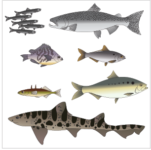Longfin smelt were what hooked Jim Ervin when he first learned about the UC Davis South Bay Fish Survey through a presentation at the 2012 Bay-Delta Science Conference. “They were catching them right there in our effluent channel!” recalls Ervin, a self-trained naturalist and former compliance manager for the San Jose-Santa Clara Regional Wastewater Facility.
Intrigued, he contacted the researchers, rode with them on their next survey, and has been part of the project ever since, devoting more time to it after retiring from his wastewater facility job in 2018. “I have a free ticket to ride on the boat with fish experts who’ve been doing this for years,” he says. He began his Fish in the Bay blog in 2016, posting spreadsheets and photographs of the catch.
Ervin has photographed and posted about such unlikely creatures as guitarfish, pregnant male pipefish, tonguefish (small flatfish the size and shape of the human tongue), red Irish lords, and parasitic copepods infesting the bodies of leopard sharks. His interests have grown beyond fish to include what he calls the “bugs” — marine invertebrates like shrimp, amphipods, snails, and sea slugs — as well as the harbor seals that haul out in the sloughs and the Bay ducks that may be keeping the Corbula population down. In January, he posted about catching a slew of non-native mud shrimp, probably flushed out of their burrows upstream by the previous month’s heavy rains, and immediately heard from a shrimp specialist in Oregon.
To Lewis, Ervin is a naturalist in the tradition of Charles Darwin and the late E. O. Wilson. “They went around and made observations,” Lewis says. “We’ve devalued people who do that. What Jim Ervin is doing is the absolute foundation of science. He’s much more than a photographer. He’s the Lorax of the Estuary — he stands for the fish.”
